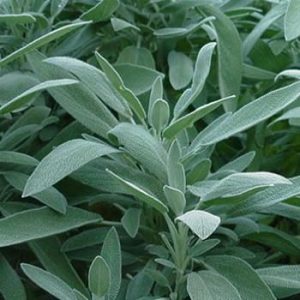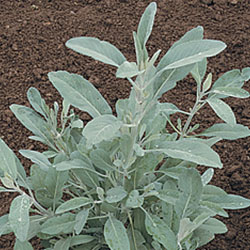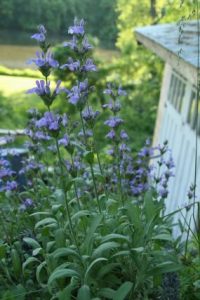Sage (Salvia officinalis)
Alias names for Sage: Broadleaf Sage, Common Sage, Dalmatian Sage, Garden Sage, Kitchen Sage, Narrow-leaved Sage, Sage, Salvia, Sarubia, Spanish Sage, Tibbi Adacayi, Golden Sage, Pineapple Sage, Golden Pineapple Sage, Variegated Sage, Berggarten Sage, Purple Sage, Tricolor Sage, White Sage, Salvia apiana
Pictures of Sage:

Photo of common sage (Salvia officinalis).

Photo of ceremonial white sage.

Salvia officinalis (Sage) flowers
References for Sage pictures:
- Common Sage: https://www.almanac.com/image/sage
- https://www.bhg.com/gardening/plant-dictionary/herb/sage/
- Sage flowers: https://www.finegardening.com/sage-bloom
- White Sage: https://www.seedsavers.org/onlinestore/Herbs/Herb-White-Sage.html (Awesome place to order organic GMO-free seed).
About Sage: Sage is an evergreen. It can grow up to 32 in. The stems are square and hairy that end in leaves that can range in color from gray (white), green, purple, blue and pink and white. Giving a clue to its medicinal use is Sage’s botanical name “Salvia” which is Latin meaning ‘to cure’. Sage is grown all around the world but is native to the Mediterranean. It is grown from seed or cuttings from an established plant and thrives in sunny conditions. The leaves are harvested during the summer and the plants replaced every 3-4 years. Purple Sage is preferred as the medicinal variety. White sage is used for purification ceremonies and smudging to energetically clear spaces. Common sage is most commonly found as a culinary herb and is used in cooking especially in sausage, stuffing, soups and stews. Sage was awarded the International Herb Association “Herb of the Year” in 2001.
Key Actions and Historical Uses of Sage:
- Anti-Inflammatory
- Antimicrobial
- Antiseptic
- Aromatic
- Astringent
- Biliousness
- Bites
- Candida
- Canker Sores
- Carminative
- Dental Abscess
- Diarrhea
- E.coli
- Estrogenic
- Flatulence
- Gargles
- Gingivitis
- Hemorrhage
- Hot Flashes
- Infected Gums
- Insect Repellant
- Irregular Menstruation
- Joint Pain
- Kidney Trouble
- Laryngitis
- Lethargy
- Lice
- Liver Complaints
- Memory improvement
- Mouth Ulcers
- Nerve Tonic
- Nervousness
- Night Sweats
- Palsy
- Pharyngitis
- Poor Digestion
- Quinsy
- Reduces Sweating
- Relieves Muscle Spasms
- Rheumatism
- Salmonella
- Sharpen Senses
- Sore Gums
- Sore Throat
- Staph
- Stimulating Tonic
- Stings
- Stress Headache
- Tonic
- Tonsillitis
- Treat Asthma
- Typhoid Fever
How Sage is Used and How it Works:
The volatile oil, Thujone, in the leaves have antiseptic and astringent properties. It also contributes to the hormonal effect that Sage has. The phenol Rosmarinic acid, is anti-inflammatory and combined with its volatile oil it relieves muscle spasms and is antimicrobial. The Phenolic acid is potent against Staphylococcus aureus. In vitro, sage has been used to treat E. coli, and Salmonella.
- Bites and Stings: Fresh leaves can be used as a first aid remedy and they can be rubbed directly on stings and bites.
- Sore Throats: An infusion of sage can be gargled for sore throats.
- Digestive tonic: you can take a tincture internally with water two times daily.
- Nerve Tonic: Sage can both calm and stimulate the nervous system.
- Hormonal Stimulant: Sage can encourage a better blood flow during menstruation.
- Milk production: It can also reduce breast-milk production.
- Asthma remedy: Dried leaves of sage has traditionally been burned in combination with other herbs.
Parts and forms of Sage used:
- Infusion
- Flowers
- Fresh and Dried Leaves
- Tincture
- Herbal Smoking mixture
- Tea
- Tender Stems
- Tincture
- Essential Oil
- Dried Leaves encapsulated
Properties of Sage: Anti-bacterial, anti-fungal, anti-hydrotic, anti-inflammatory, anti-microbial, antioxidant, anti-septic, anti-spasmodic, anti-viral, aromatic, appetite stimulant, astringent, balances female hormones (estrogens), carminative, emmenagogue, estrogenic, relaxant, spasmolytic, Vermifuge (deworming agent)
Chemical Constituents of Sage: Volatile oil—Thujone (50%), Diterpene Bitters, Flavonoids, Phenolic Acids, Tannins volatile oils (including thujone, Cineole, Borneol, Linalool, Camphor, Pinene), Estrogenic substances, Salvin and Carnosic acid, Flavonoids, Phenolic acids, Rosmarinic acid, Tannin
Contradictions, safety issues, concerns, harmful drug interactions and allergy precautions for Sage: During pregnancy or if epileptic, do not take therapeutic doses. Sage should not be used to reduce sweating during a fever. Excessive use may produce toxicity.
Helpful Links and References for Sage:
- Sage the herb: https://www.herbwisdom.com/herb-sage.html
- About Sage: https://www.almanac.com/plant/sage
- Salvia officinalis: https://en.wikipedia.org/wiki/Salvia_officinalis
- Nutritional benefits of sage https://www.nutrition-and-you.com/sage-herb.html
- Sage: https://www.whfoods.com/genpage.php?tname=foodspice&dbid=76